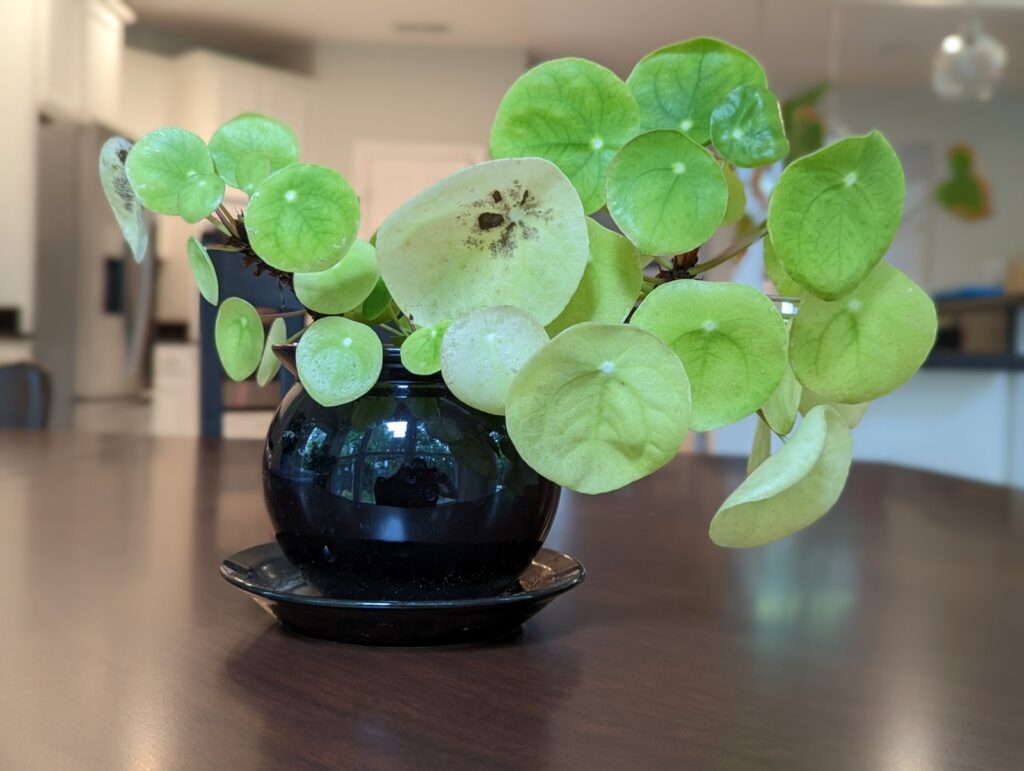Everything to Know About Pilea Fertilizer
Pilea Peperomioides are cute little plants. They have uniquely shaped leaves that are circular. It's earned the nickname the sharing plant. When cared for correctly, it readily sprouts offshoots that can be plucked and easily turned into new Pileas.
I'm writing this post about Pilea fertilizer because I happen to have a severely under-fertilized Pilea at the moment. Unfortunately, this Pilea was left in my office at the start of the pandemic and I was unable to get back in to take it home. For the last two years, some very nice people on the cleaning crew have been watering it when they can. It has survived these past two years, but it doesn't look great.

What's the Best Pilea Fertilizer
You definitely don't need any fertilizer that is specially formulated for Pileas. Pileas in most normal conditions will do well with a balanced houseplant fertilizer. Balanced means even ratios of the three nutrients n-p-k, nitrogen, phosphorous, and potassium. Nitrogen is generally associated with growing healthy foliage. Phosphorous is associated with fruiting and blooming. Potassium is associated with overall plant health.
The typical houseplant fertilizer has ratios that are close in number like 10-10-10, which I mentioned earlier is a balanced fertilizer. You often see it called all-purpose. In addition to the fertilizer being balanced, it's best if it is liquid or water-soluble. Water-soluble just means it can be dissolved in water. Liquid and water-soluble fertilizers are able to be absorbed immediately, which in general is preferable. Slower-release fertilizers can get you into a tricky situation if you don't remember the last time you fertilized or how much you used.
When using any fertilizer it's important to follow the frequency and dosing directions. If the directions say to dilute in water, you should dilute. If it gives you instructions on how much to use for your size of pot or plant, follow that. Generally speaking, you can also follow the frequency of feeding on the instructions. However, Pileas are light feeders, so I recommend sticking to monthly feeding during the growing season. Do not fertilize at all during winter dormancy.
Overfertilized Pilea and Under-fertilized Pilea
If you return back to my picture above, you will see clear signs of under-fertilization. Nitrogen deficiency presents as yellowish pale green leaves. It's pretty obvious that I have an under-fertilized Pilea. A potassium deficiency can also present as yellowing, scorching, or even curling of the leaves. Phosphorous deficiency presents as a lack of growth or darkening of leaves. If you want to know for sure if you have a nutrient deficiency then you should use soil rapitests. They measure the levels of the three main nutrients and the ph.
If your plant is lacking nutrients or showing any of these signs, you'll want to start fertilizing. Start slow. It's okay to use a balanced fertilizer even if you suspect your Pilea might be deficient in one nutrient. Watch your plant to see how it reacts in a week or two. You should see some new growth if it's the growing season. New growth should look healthier. You may also get some color back into your pale leaves if they aren't too far gone.
A sign that a Pilea is overfertilized is also slow or stalled growth. Definitely get the soil rapitests if you think you have overfertilized. You don't really want to do the treatment for overfertilization unless you're sure. To treat an overfertilized Pilea, you should repeatedly flush the soil with water. Do it in a sink or a bathtub, because it will probably get messy. You want to pour a lot of water so that it flows out of the bottom of your pot. You may need to do this several times. Be cautious of waterlogging the roots, because you don't want to add root rot to your fertilization problems. If you do have this problem, I have a post on overwatered Pileas as well.
How Often to Fertilize Pileas
I mentioned earlier that Pileas aren't particularly heavy feeders. I generally don't feed my Pileas more than once a month. The fertilizer you use may instruct you to feed it every week. Many factors are at play though, so you might have to just experiment. If the ratios on the fertilizer are very low, like all the numbers are under 5, then it's pretty diluted and you may be able to feed more than once a month. Another important note about fertilization is that it should only be done during the growing season. When the plant is dormant in the winter, you should not be fertilizing it. It's not good to encourage growth when the plant is not getting as much light. If you encourage growth in the winter it will typically be unhealthy because of the lack of adequate light.
Do you have any remaining questions about Pilea Fertilizer? Let us know below in the Comments section.
Add new comment